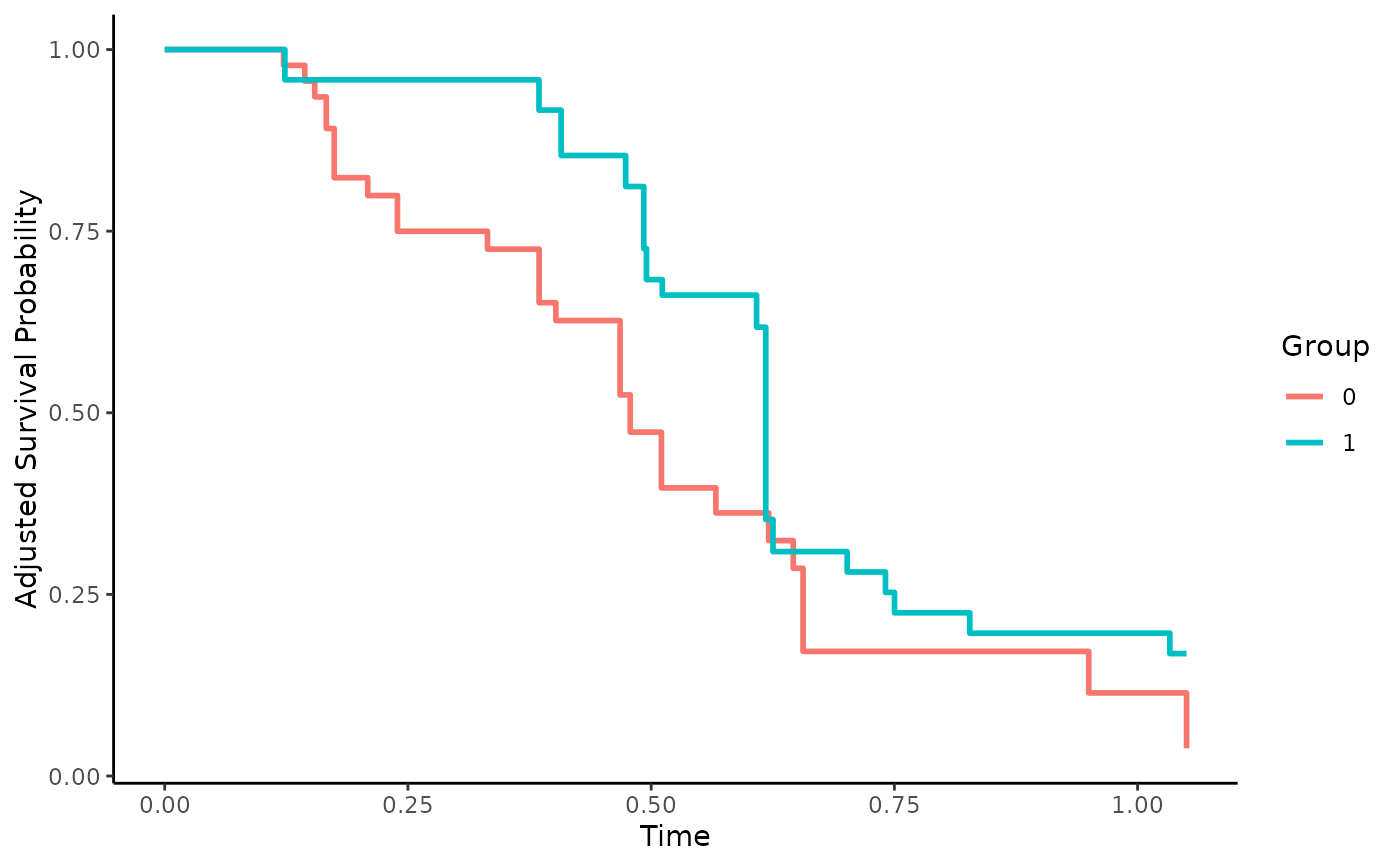
Using Propensity-Score Matching to Calculate Adjusted Survival Curves
surv_matching.RdThis page explains the details of estimating adjusted survival curves using propensity-score matching for single event time-to-event data (method="matching" in the adjustedsurv function). All regular arguments of the adjustedsurv function can be used. Additionally, the treatment_model argument has to be specified in the adjustedsurv call. Further arguments specific to this method are listed below.
Arguments
- treatment_model
[required] Must be either a model object with
variableas response variable or a vector of previously estimated propensity scores.- gtol
Tolerance at which estimated treatment assignment probabilities are truncated. Every propensity score bigger than 1 -
gtolis set to 1 -gtoland every propensity score smaller thangtolis set togtol. Useful when there are extreme propensity scores close to 0 or 1. Defaults to 0.001.- ...
Further arguments passed to the
Matchfunction of the Matching Package.
Details
Type of Adjustment: Requires a model describing the treatment assignment mechanism. This must be either a
glmobject.Doubly-Robust: Estimates are not Doubly-Robust.
Categorical groups: Only two groups in
variableare allowed. Must be a factor variable with exactly two levels.Approximate Variance: Calculations to approximate the variance and confidence intervals are currently not available. Bootstrap confidence intervals can however be calculated with all supported models. See
?adjustedsurvfor more information on bootstrapping.Allowed Time Values: Allows both continuous and integer time.
Bounded Estimates: Estimates are guaranteed to be bounded in the 0 to 1 probability range.
Monotone Function: Estimates are guaranteed to be monotone.
Dependencies: This method relies on the Matching package.
Using the estimated propensity score, the individual observations in the dataset are matched to each other creating a new dataset in which the covariate distributions are balanced in respect to the two groups defined by variable. A simple Kaplan-Meier estimator is then used to calculate the confounder-adjusted survival curves. This corresponds to the method described in Austin (2014). Details on the algorithm used for matching can be found in the documentation of the Matching package.
We choose not to implement other matching based estimators (see Winnett & Sasieni (2002), Galimberti et al. (2002) and Austin (2020)) because of the wide range of matching algorithms and parameters. Trying to automate the matching process in a function like this would, in our opinion, disrupt the workflow of the user while also encouraging suboptimal practices. We however included this simple version of a matching estimator as a reference and to raise the awareness that using matching is a valid method to obtain adjusted survival curves.
Simulation studies have shown that this particular method as implemented here is significantly less efficient than other methods included in this R-Package. While it does produce unbiased estimates, the variation in these estimates is very high. We suggest using one of the other available methods.
Value
Adds the following additional objects to the output of the adjustedsurv function:
match_object: The object creates using theMatchfunction.survfit_object: Thesurvfitobject fit on the matched data.
References
Peter C. Austin (2014). "The Use of Propensity Score Methods with Survival or Time-To-Event Outcomes: Reporting Measures of Effect Similar to those Used in Randomized Experiments". In: Statistics in Medicine 33, pp. 1242-1258
Angela Winnett and Peter Sasieni (2002). "Adjusted Nelson-Aalen Estimates with Retrospective Matching". In: Journal of the American Statistical Association 97.457, pp. 245-256
Stefania Galimberti, Peter Sasieni, and Maria Grazia Valsecchi (2002). "A Weighted Kaplan-Meier Estimator for Matched Data with Application to the Comparison of Chemotherapy and Bone-Marrow Transplant in Leukaemia". In: Statistics in Medicine 21, pp. 3847-3864
Peter C. Austin, Neal Thomas, and Donald B. Rubin (2020). "Covariate-Adjusted Survival Analyses in Propensity-Score Matched Samples: Imputing Potential Time- To-Event Outcomes". In: Statistical Methods in Medical Research 29.3, pp. 728-751
Examples
library(adjustedCurves)
if (requireNamespace("Matching")) {
library(Matching)
set.seed(42)
# simulate some data as example
sim_dat <- sim_confounded_surv(n=50, max_t=1.2)
sim_dat$group <- as.factor(sim_dat$group)
# estimate treatment assignment model
glm_mod <- glm(group ~ x1 + x2 + x4 + x6, data=sim_dat, family="binomial")
# calculate adjusted survival curves
adjsurv <- adjustedsurv(data=sim_dat,
variable="group",
ev_time="time",
event="event",
method="matching",
treatment_model=glm_mod)
# Alternatively, supply the propensity score directly
# Here we use the logistic regression to calculate it, so we get
# exactly the same result. The propensity score can be calculated in
# any other way in practice, allowing flexibility
ps_score <- glm_mod$fitted.values
adjsurv <- adjustedsurv(data=sim_dat,
variable="group",
ev_time="time",
event="event",
method="matching",
treatment_model=ps_score)
# plot the curves
plot(adjsurv)
}
